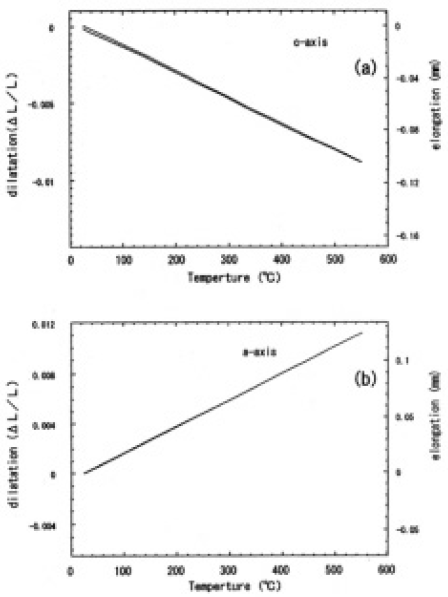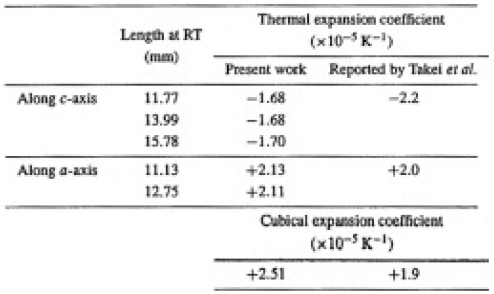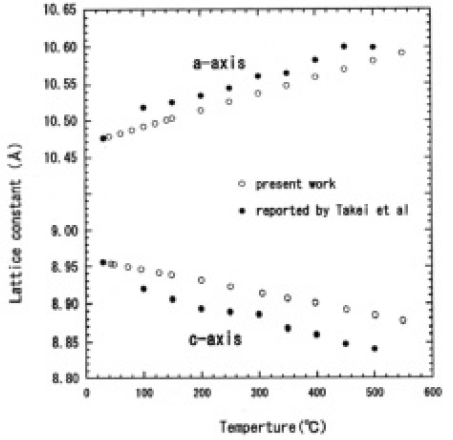光技術情報誌「ライトエッジ」No.20(2000年12月発行)
Japanese Journal of Applied Physics
Jpn. J Appl. Phys. Vol. 39 (2000) pp. 1256-1257
Part 1, No. 3A March 2000
©2000 Public Board, Japanese Journal Applied Physics
Short Note
Thermal Expansion Coefficients of Optical Crystal CsLiB6O10
Sayu YAMADA, Yukihiro MORIMOTO and Shinataro MIYAZAWA
USHIO Research Institute of Technology Inc., 1-90 Komakado, Gotenba, Shizuoka 412-0038, Japan
(Received September 8, 1999; accepted for publication November 29, 1999)
Thermal expansions of bulk CsLiB6O10 (CLBO) crystal were measured by a dilatomater for the first time. Thermal expansion measurements were carried out in the temperature range between room temperature and 500°C. The obtained expansion coefficients for tetragonal c-and a-axes were-1.69±0.01 x 10-5/K and 2.12±0.01 x 10-5/K, respectively. The thermal expansion coefficient along the c-axis was smaller than that reported previously.
KEYWORDS : optical nonlinear crystal, CsLiB6O10 (CLBO), thermal expansion, dilatation
One of the recent advances in optical nonlinear crystals which enable us to obtain higher order harmonic generations, such as 266 nm (4ω) and 213 nm (5ω) from a Nd: YAG laser (1064 nm), is the development of a new borate crystal, CsLiB6O10 (CLBO). This crystal has superior optical nonlinearities in the ultra-violet wavelength regions; for example, the shortest optical absorption edge lying at around 180 nm. On the other hand, the crystal has less mechanical properties which can be associated with a large anisotropy of the thermal expansion coefficients between the crystallographic c-and a-axes.
Takei et al.1) reported the thermal expansion of CLBO for the first time by measuring lattice constants using a high-temperature X-ray powder diffractometer, and found that the thermal expansion coefficient along the c-axis is negative, while that along the a-axis is positive. However, as they reported in the literature, the X-ray diffraction lines became considerably broad at elevated temperatures, which may lead to fluctuaiton of the lattice constants. In addition, the lattice constants changed abruptly to about 100°C, showing irregular jumps from room temeprature to 100°C. CLBO belongs to a tetragonal symmetry from the growth temperature to room temperature (RT); therefore, the jumps of the lattice constants must be caused by measurement processes.
This letter reports the linear thermal expansion coefficients of CLBO single crystal along the crystallographic c-and a-axis using bulk samples by means of dilatometry. As a result, thermal expansions along both directions were evaluated more accurately, and in particular the ambiguity up to 100°C from RT was refined clearly.
A CLBO single crystlal using in this study was grown by the top-seeded solution growth (TSSG) method. Typical growth conditions are described elsewhere.2) From a grown boule, approximatelry 3 x 3 x 7-15 mm3 samples along the c- and a-axes were prepared with a Xray back Laue technique. Orientation accuracy was ±0.3°. In this experiment, these as-cut rods were used as samples without any further treatment.
Thermal expansions were directly measured for RT up to 500°C under N2 gas flow. An Al2O3 ceramic rod of a length close to that of each CLBO sample was used as a reference, and the measurement accuracy was calibrated by its thermal expansion coefficient. The heaitng followed by cooling measurements were carried out 2 or 3 times to clarity their reproducibility.
Figures 1(a) and 1(b) show the as-recorded thermal expansion dilatation (ΔL/L) of the cand a-axes samples, respectively. The crystal undergoes almost linear shrinkage along the c-axis and elongation along the a-axis upon heating. Because of its sensitivity, a fractional change of sample length is often found before and after the measurement, as in Fig. 1(a). Takei et al.1) reported remarkable jumps from RT to about 100°C for both the crysttallogrophic directions. It is noted that no remarkable irregularities from RT to around 100°C were observed. This discrepancy must be caused by the diffrence in samples used in experiments; Takei et al. used powder samples, while bulk samples were investigated in the present work. It was clearly demonstrated3) that CLBO was very sensitive to moisture even for a short period, and there-fore a powder sample must be hydrated to some degree during smaple preparation in air.

From our direct measurements of the thermal expansion, we deduced linear thermal expansion coefficients along the c-and a-axes, as summarized in Table I. In the table, we compare the values for different sample lengths, but each thermal expansion coefficient is almost the same within the error of measurements. The evaluated thermal expansion coefficient along the a-axis was 2.12±0.01x105/K, which is roughly even with the reported value, 2.0x10-5/k, while that along the c-axis was _1.69± 0.01x120-5/K, which does not coincide fairly with the reported one, -2.2x10-5/k, even in the case for which we calculated the dilatation from 100 to 500°C. As is shown in Fig. 1, any irregularities or discontinuities from RT up to 500°C were recognized by the recorded thermal expansion.

Jpn. J. Appl. Phys. Vol. 39 (2000) Pt. 1, No. 3A
Table. 1. Thermal expansion coefficient is defined as ΔL/LΔT, where L is the sample length, ΔL and ΔT are the elongation and the temperature difference, respectively. Cubical expansion coefficient is defind as ΔV/V0ΔT
Figure 2 shows the temperature dependence of lattice constants calculated from the measured dilations with temperature using the lattice constants of CLBO at room temperature, i.e., c = 8.956Å and a = 10.476Å,1) where the lattice constants reported by Takei et al. were replotted for comparions. The temperature variations of the a-axis lattice constant are close to each other, while those of the caxis difer to some degree. Here again, we note the difference in thermal expansion from RT up to about 100°C. Our results are based on the direct measurement of the length of bulk sampls under varying temperatures.

Fig. 2. Changes in the lattice constant calculated from the measured dilatations.
The cubical expansion coefficient defined as ΔV/ΔV0Δ T was 2.51x10-5/K, as listed in Table I, which also doesn’t coincide fairly with the reported one, 1.9x10-5/K.1) This discrepancy must result from the difference in thermal expansion of the c-axis.
In conclusion, the thermal expansion coefficnents of TSSG-grown CLBO were directly measured from RT up to 500°C using a dilatometer using bulk samples. Thermal expansion coefficients along the c-and a-axes were-1.69±0.01x10-5/K and 2.12±0.01x10-5/K, respectively. The present values are useful in designing the CLBO’s optical unit in a solidstagte laser system.
The authors would like to thank to Mr. Y. Kagebayashi (URIT Inc.) for supplying the CLBO crystals, and Mr. N. Suzuki (URIT Inc.) for his technical support in preparing the samples. They are also indebted to Professor T. Sasaki and Dr. Y. Mori (Osaka University) for their valuable suggestions on the crystal growth of CLBO.

